Austrian actress Eva May (1902-1924) was the daughter of film star Mia May and producer Joe May. It was only natural that she would follow suit. She became ‘everybody’s darling’ but in 1924 she committed suicide.
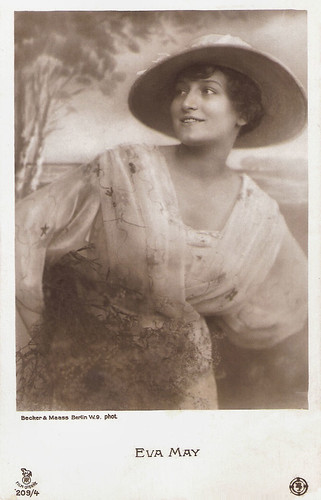
German postcard by Rotophot in the Film-Sterne series, no. 203/4. Photo: Becker & Maass, Berlin / Ring-Film.
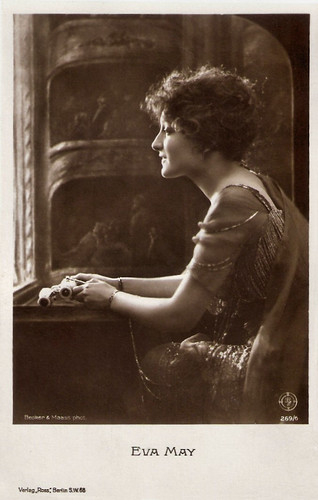
German postcard by Ross Verlag, Berlin, no. 269/1, 1919-1924. Photo: Becker & Maass / Ring-Film.
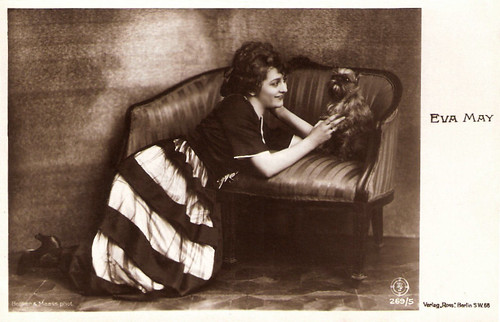
German postcard by Ross Verlag, Berlin, no. 269/5, 1919-1924. Photo: Becker & Maass / Ring-Film.
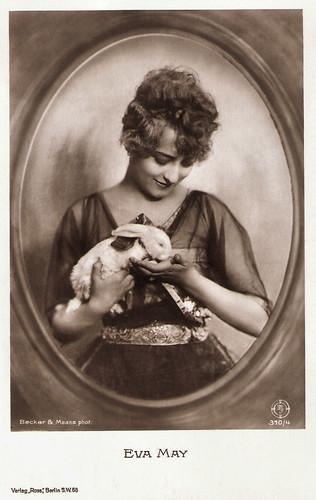
German postcard by Ross Verlag, Berlin, no. 310/4, 1919-1924. Photo: Becker & Maass / Ring-Film.

German postcard by Ross Verlag, Berlin, no. 468/1, 1919-1924. Photo: Frieda Riess.
Eva May was born as Eva Maria Mandl in 1902 in Vienna, Austria-Hungary (now Austria). She was the daughter of the film director Joe May and his wife, film star Mia May. Eva was very often in her father's studio and caught the acting bug very early.
In 1914 she acted for the first time in a Stuart Webbs-Detective film called Stuart Webbs: Die geheimnisvolle Villa/The Black Triangle (Joe May, 1914). Ernst Reicher played Webbs and in the cast were also Werner Krauss, Max Landa, and Mia May
From 1918 she worked exclusively for the Ring-Film GmbH, managed by Manfred Liebenau, working as a director under the nom de plume of Erik Lund. They married when she was only 16.
She appeared in films like Erträumtes/Something dreamed (Adolf Gartner, 1918) with Olga Engl, Sadja (Adolf Gärtner, Erik Lund, 1918) with Hans Albers, and Die Braut des Entmündigten/The bride of the incapacitated (Erik Lund, 1919) with Hermann Thimig.
Liebenau and May created their own Eva-May-Serial for which Eva also wrote the scripts. She was treated kindly by the press and rose to ‘Jedermanns Liebling’ because of her nice roles.
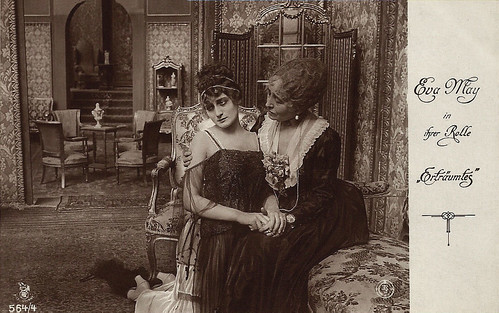
German postcard by Rotophot in the Film-Sterne series, no. 564/4. Photo: Ring-Film. Eva May in Erträumtes/Something dreamed (Adolf Gartner, 1918).
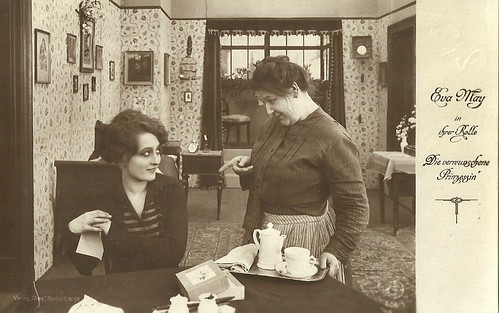
German postcard by Ross Verlag, Berlin, no. 608/1. Photo: Ring-Film. Eva May (left) in Die verwunschene Prinzessin/The enchanted princess (Erik Lund, 1919).

German postcard by Ross Verlag, no. 619/3. Photo: Film-Kunst / Ring-Film. Eva May in the German silent film Die Fee von Saint Ménard (Erik Lund, produced and offered for censorship in 1919, released February 1920), scripted by Ruth Goetz, and with cinematography by Curt Courant.
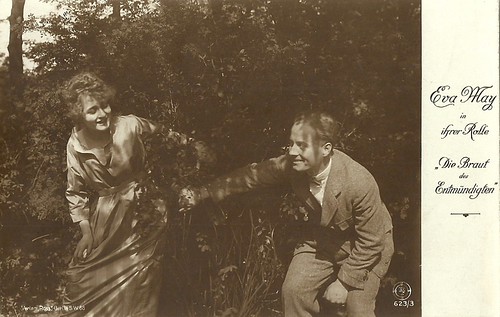
German postcard by Ross Verlag, Berlin, no. 623/3. Photo: Ring-Film. Eva May in the German silent film Die Braut des Entmündigten/The bride of the incapacitated (Erik Lund, 1919). The man on the right is Hermann Thimig.

German postcard by Ross Verlag, no. 624/1. Photo: Film-Kunst. Eva May in Das hohe Lied der Liebe. Though indicated in the German Early Film Database as a film by Erik Lund for Ring-Film, dating 1919, this title is not mentioned in Filmportal.de and IMDb, so perhaps it was not released in Germany, or retitled. The German Early Film Database mentions the film censoring in 1919, but lists no screenings. The back of the card confirms that Lund was the director and also states that cinematography was by Curt Courant.
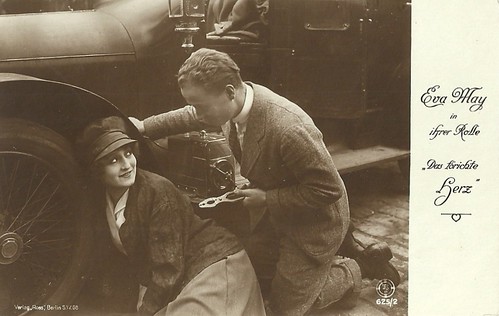
German postcard by Ross Verlag, Berlin, no. 625/2. Photo: Ring-Film. Eva May in Das törichte Herz/The foolish heart (Erik Lund, 1919). The man on the right is probably Hermann Thimig.
After 1920 Eva May worked again together with her father in films like Die Legende von der heiligen Simplicia/The Legend of Holy Simplicity (Joe May, 1920) with Alfred Gerasch, and Junge Mama/Young Mama (Uwe Jens Krafft, Joe May, 1921) with Victor Varconi. Privately Eva May was regarded as very difficult and sometimes freakish, according to Thomas Staedeli at Cyranos.
She played for other popular directors like Karl Grune in Der Graf von Charolais/The Count of Charolais (1922) featuring Wilhelm Dieterle, and Max Mack in Die Fledermaus/The Bat (1923) opposite Lya De Putti. She starred with Alfred Abel in Scheine des Todes/Certificates of death (1923) directed by her second husband, Lothar Mendes.
May also appeared in successful films like Alt Heidelberg/Old Heidelberg (Hans Behrendt, 1923) opposite Paul Hartmann, and Paganini (Heinz Goldberg, 1923) starring Conrad Veidt. Her third marriage to director Manfred Noa ended after a short time.
As a result of her lifestyle, temper, and method of working there were more and more quarrels between her and her father, Joe May. On the night of the 9th to 10th September 1924, Eva May brought her life to an end with a gunshot. She was only 22.
It had not been the first attempted suicide. One year earlier Eva had cut open her arteries after film worker Rudolf Sieber broke off their engagement and married Marlene Dietrich. She was given medical treatment in time to save her life.
Eva May's last film was Der Geheime Agent/The Secret Agent (Erich Schönfelder, 1924) with Lucie Höflich and Karl Lamac. All together Eva had appeared in around 30 films. Her mother Mia May was so devastated by her daughter's suicide that she finished her career and never acted again. Joe May retired from directing in 1944.
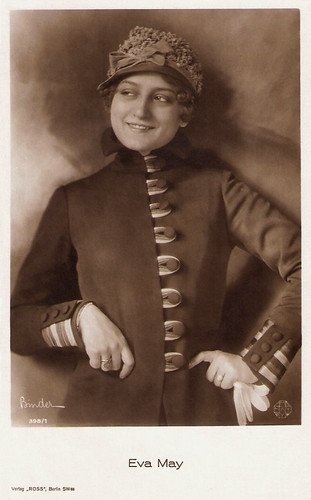
German postcard by Ross Verlag, Berlin, no. 398/1, 1919-1924. Photo: Alex Binder / May Film.
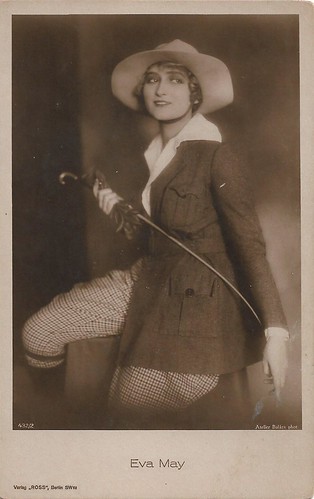
German postcard by Ross Verlag, Berlin, no. 432/2, 1919-1924. Photo: Atelier Balàzs, Berlin.
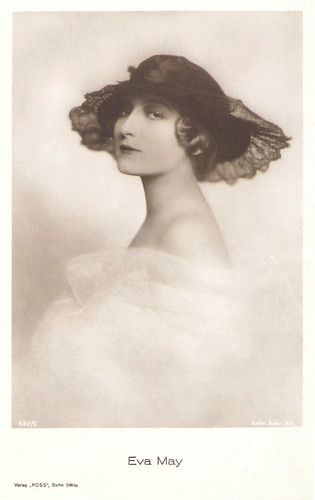
German postcard by Ross Verlag, Berlin, no. 432/5, 1919-1924. Photo: Atelier Balázs, Berlin.
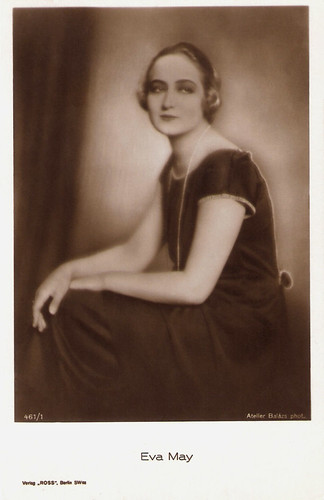
German postcard by Ross Verlag, Berlin, no. 461/1, 1919-1924. Photo: Atelier Balázs.
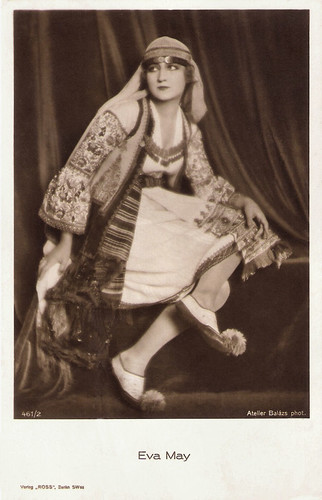
German postcard by Ross Verlag, Berlin, no. 461/2, 1919-1924. Photo: Atelier Balázs.
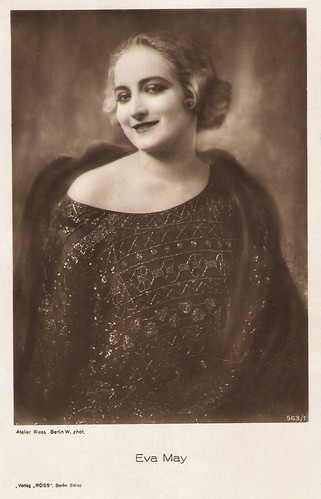
German postcard by Ross Verlag, Berlin, no. 563/1, 1919-1924. Photo: Atelier Riess.
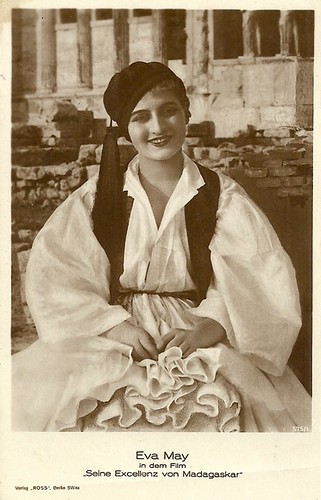
German postcard by Ross Verlag, no. 575/1. Photo: PAGU. Eva May in the two-part film Seine Exzellenz von Madagaskar (Georg Jacoby, 1921).
Sources: Thomas Staedeli (Cyranos), Jessica Keaton (Silence is Platinum), Wikipedia and IMDb.
This post was last updated on 27 March 2021.

German postcard by Rotophot in the Film-Sterne series, no. 203/4. Photo: Becker & Maass, Berlin / Ring-Film.

German postcard by Ross Verlag, Berlin, no. 269/1, 1919-1924. Photo: Becker & Maass / Ring-Film.

German postcard by Ross Verlag, Berlin, no. 269/5, 1919-1924. Photo: Becker & Maass / Ring-Film.

German postcard by Ross Verlag, Berlin, no. 310/4, 1919-1924. Photo: Becker & Maass / Ring-Film.

German postcard by Ross Verlag, Berlin, no. 468/1, 1919-1924. Photo: Frieda Riess.
Everybody's darling
Eva May was born as Eva Maria Mandl in 1902 in Vienna, Austria-Hungary (now Austria). She was the daughter of the film director Joe May and his wife, film star Mia May. Eva was very often in her father's studio and caught the acting bug very early.
In 1914 she acted for the first time in a Stuart Webbs-Detective film called Stuart Webbs: Die geheimnisvolle Villa/The Black Triangle (Joe May, 1914). Ernst Reicher played Webbs and in the cast were also Werner Krauss, Max Landa, and Mia May
From 1918 she worked exclusively for the Ring-Film GmbH, managed by Manfred Liebenau, working as a director under the nom de plume of Erik Lund. They married when she was only 16.
She appeared in films like Erträumtes/Something dreamed (Adolf Gartner, 1918) with Olga Engl, Sadja (Adolf Gärtner, Erik Lund, 1918) with Hans Albers, and Die Braut des Entmündigten/The bride of the incapacitated (Erik Lund, 1919) with Hermann Thimig.
Liebenau and May created their own Eva-May-Serial for which Eva also wrote the scripts. She was treated kindly by the press and rose to ‘Jedermanns Liebling’ because of her nice roles.

German postcard by Rotophot in the Film-Sterne series, no. 564/4. Photo: Ring-Film. Eva May in Erträumtes/Something dreamed (Adolf Gartner, 1918).

German postcard by Ross Verlag, Berlin, no. 608/1. Photo: Ring-Film. Eva May (left) in Die verwunschene Prinzessin/The enchanted princess (Erik Lund, 1919).

German postcard by Ross Verlag, no. 619/3. Photo: Film-Kunst / Ring-Film. Eva May in the German silent film Die Fee von Saint Ménard (Erik Lund, produced and offered for censorship in 1919, released February 1920), scripted by Ruth Goetz, and with cinematography by Curt Courant.

German postcard by Ross Verlag, Berlin, no. 623/3. Photo: Ring-Film. Eva May in the German silent film Die Braut des Entmündigten/The bride of the incapacitated (Erik Lund, 1919). The man on the right is Hermann Thimig.

German postcard by Ross Verlag, no. 624/1. Photo: Film-Kunst. Eva May in Das hohe Lied der Liebe. Though indicated in the German Early Film Database as a film by Erik Lund for Ring-Film, dating 1919, this title is not mentioned in Filmportal.de and IMDb, so perhaps it was not released in Germany, or retitled. The German Early Film Database mentions the film censoring in 1919, but lists no screenings. The back of the card confirms that Lund was the director and also states that cinematography was by Curt Courant.

German postcard by Ross Verlag, Berlin, no. 625/2. Photo: Ring-Film. Eva May in Das törichte Herz/The foolish heart (Erik Lund, 1919). The man on the right is probably Hermann Thimig.
Gunshot
After 1920 Eva May worked again together with her father in films like Die Legende von der heiligen Simplicia/The Legend of Holy Simplicity (Joe May, 1920) with Alfred Gerasch, and Junge Mama/Young Mama (Uwe Jens Krafft, Joe May, 1921) with Victor Varconi. Privately Eva May was regarded as very difficult and sometimes freakish, according to Thomas Staedeli at Cyranos.
She played for other popular directors like Karl Grune in Der Graf von Charolais/The Count of Charolais (1922) featuring Wilhelm Dieterle, and Max Mack in Die Fledermaus/The Bat (1923) opposite Lya De Putti. She starred with Alfred Abel in Scheine des Todes/Certificates of death (1923) directed by her second husband, Lothar Mendes.
May also appeared in successful films like Alt Heidelberg/Old Heidelberg (Hans Behrendt, 1923) opposite Paul Hartmann, and Paganini (Heinz Goldberg, 1923) starring Conrad Veidt. Her third marriage to director Manfred Noa ended after a short time.
As a result of her lifestyle, temper, and method of working there were more and more quarrels between her and her father, Joe May. On the night of the 9th to 10th September 1924, Eva May brought her life to an end with a gunshot. She was only 22.
It had not been the first attempted suicide. One year earlier Eva had cut open her arteries after film worker Rudolf Sieber broke off their engagement and married Marlene Dietrich. She was given medical treatment in time to save her life.
Eva May's last film was Der Geheime Agent/The Secret Agent (Erich Schönfelder, 1924) with Lucie Höflich and Karl Lamac. All together Eva had appeared in around 30 films. Her mother Mia May was so devastated by her daughter's suicide that she finished her career and never acted again. Joe May retired from directing in 1944.

German postcard by Ross Verlag, Berlin, no. 398/1, 1919-1924. Photo: Alex Binder / May Film.

German postcard by Ross Verlag, Berlin, no. 432/2, 1919-1924. Photo: Atelier Balàzs, Berlin.

German postcard by Ross Verlag, Berlin, no. 432/5, 1919-1924. Photo: Atelier Balázs, Berlin.

German postcard by Ross Verlag, Berlin, no. 461/1, 1919-1924. Photo: Atelier Balázs.

German postcard by Ross Verlag, Berlin, no. 461/2, 1919-1924. Photo: Atelier Balázs.

German postcard by Ross Verlag, Berlin, no. 563/1, 1919-1924. Photo: Atelier Riess.

German postcard by Ross Verlag, no. 575/1. Photo: PAGU. Eva May in the two-part film Seine Exzellenz von Madagaskar (Georg Jacoby, 1921).
Sources: Thomas Staedeli (Cyranos), Jessica Keaton (Silence is Platinum), Wikipedia and IMDb.
This post was last updated on 27 March 2021.
No comments:
Post a Comment